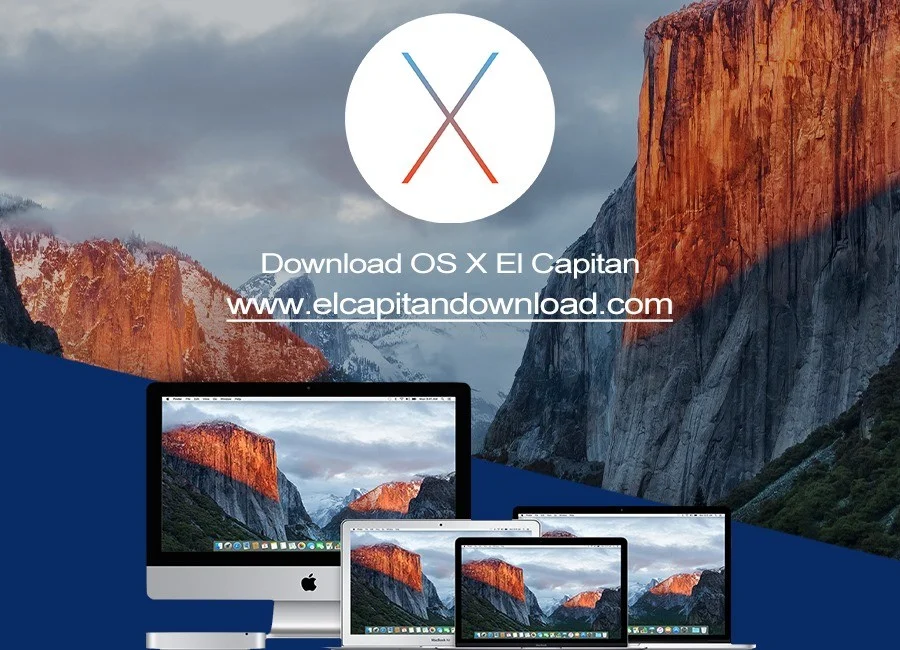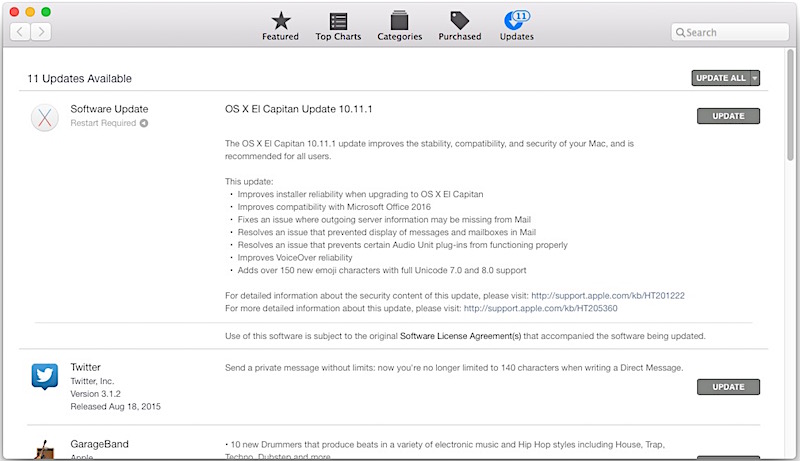Jul 05, 2021 • Filed to: Solve Mac Problems • Proven solutions
The Direct Download Links of OS X 10.11.6 Delta / Combo Final.DMG Update Files are available and shared below. Features of OS X El Capitan 10.11.6. The latest OS X 10.11.6 Update includes some traditional changelog just like previous releases i.e. Bugs fixes, security improvements, performance and stability enhancements etc. Available for: OS X El Capitan 10.11.6, macOS Sierra 10.12.6, and macOS High Sierra 10.13.6 Impact: A malicious website may exfiltrate audio data cross-origin Description: Sound fetched through audio elements may be exfiltrated cross-origin. This issue was addressed with improved audio taint tracking. CVE-2018-4278: Jun Kokatsu (@shhnjk) WebKit.
Mac users get new software updates and versions more frequently than the other operating systems. That's both the blessing and curse for the Mac users. The latest software makes your Mac device compatible with the new technological developments. Still, it also makes the existing OS obsolete. That's why most Mac users with old devices try to update their Mac to OS X El Capitan. However, you can't update your Mac to El Capitan 10.11 if your Mac runs on software later than Mac OS X 10.6 Snow Leopard.
Is OS X El Capitan Still Available for Your Mac?
OS X El Capitan (10.11) was launched on 25 September 2015, and it is an improved version of OS X Yosemite (10.10). Improved window management, quick and responsive interface, spotlight search, and enhanced graphics were the prerequisites of El Capitan OS. However, if you are planning to update your Mac to OS X El Capitan, your device must fulfill the following requirements.
Space Requirements
You can't install OS X El Capitan unless your Mac has a free space of 8.8 GB. However, that's the space you need to install El Capitan on your Mac. You might have to free more space to run your Mac more smoothly because low space slows down system performance.

Hardware Compatibility
Most of the Mac models can install and run OS X El Capitan, but in some devices, you can't use full features of this OS due to hardware limitations. For instance, you can't use AirDrop on your Mac if you don't have a WiFi network compatible with PAN. The followings are devices that are compatible with OS X El Capitan.
- MacBook introduced in 2009 or later, plus MacBook (13-inch, Aluminum, Late 2008)
- MacBook Air introduced in late 2008 or later
- MacBook Pro introduced in mid-2007 or later
- Mac mini introduced in early 2009 or later
- iMac introduced in mid-2007 or later
- Mac Pro introduced in early 2008 or later
- Xserve models introduced in early 2009
RAM Compatibility
RAM is the temporary memory that supports the system to run apps and programs efficiently. Without enough RAM, trust me, you can't even run your native operating system smoothly. Similarly, you can't install El Capitan unless you have 2 GB RAM on your Mac.
Operating System Compatibility
Operating systems play a critical role in creating an operational environment for both the software and the hardware. If you have decided to update your Mac PC, you have to make sure that your device doesn't run the OS later than Mac OS X Snow Leopard 10. 6. 8.
People Also Search:
How to Update My Mac to OS X 10.11.6/10.11.4?
After you are done with checking the compatibility of your Mac device, it's time to follow some pre rituals to prepare your device for Mac OS X El Capitan 10.11. These steps are mandatory for the successful installation of El Capitan OS into your Mac, and Apple also suggests them.
Get Your Mac Ready for El Capitan Update
Unprepared installation of a new operating system can result in disappointment. Remember that you are going to get a relatively new OS for your older Mac. To increase the hardware compatibility of your Mac, you must go through a checklist for successful installation of OS X El Capitan.
Space in your Mac: This includes freeing space both on RAM and Disk drive. 2 GB RAM and 8.8 GB of disk space are mandatory because the installer would not proceed without the fulfillment of these hardware requirements.
Minimum battery requirement: During the OS update, a computer consumes battery quicker than the regular operations. Your Mac needs to have at least 45% battery to pass through the El Capitan installation.
Active Internet Connection: You can't proceed with any OS installation without an active internet connection. Along with the installation package, your Mac would also need some side installations throughout the update. Without the support of these plugins and drivers, you would be back to square one. So, an active connection is a must.
Update Apps: Outdated apps can halt the process of updating your Mac. As soon as the installation of Mac OS X El Capitan completes, you face a software crisis. Most of your apps would stop working, leaving you with a headache. That's why don't forget to update your apps before starting the update.
Backup Your Data: There's a high chance that you would lose your data during Mac OS X EI Capitan update because the new OS makes changes in every nook and corner of your PC. To prevent the possible data loss, make a double back up—one in the Time Machine and other in the external storage device. If there is any file missing after the El Capitan update, check how to recover files after OS X update.
Begin Update Process
Your device is ready to embrace Mac OS X El Capitan 10.11 after going through the steps mentioned earlier. Now it's time for some real action.
Step 1Visit the official Mac App Store and search for Mac OS X El Capitan. Your search result would Stake you to the El Capitan page. You can also download El Capitan without the App Store by the following links.
Step 2From the official El Capitan page, you can download your required version.
Step 3Once the download is done, the El Capitan installer will pop up on your screen.


Step 4Press the 'Continue' button and wait for the installation to begin. You can proceed with the installation by following the instructions of the installer.
Step 5The installation process does not take a long time. Once the installation is done, you can restore your data from Time Machine or external drive.
Recover Lost Files After OS X El Capitan Update
Do you remember those pre-installation steps? Those steps were taken to minimize the chances of data loss during the Mac OS X El Capitan installation. Despite these precautions, you are still at the risk of unprecedented data loss. You can lose data due to the following reasons.
Data loss due to corrupted files: If your Mac contains corrupted files, you will lose your data. During installation, the new OS tries to fix or delete corrupted files. These overwritten or deleted files would not appear after installation.
Nature of Mac OS X El Capitan's update: You will replace your older OS with a new version that is not tailor-made for your Mac. That's a significant shift in the environment of your Mac. Such kinds of major updates come with uncertainty, and you can't predict whether you are going to lose your data or not.
Hardware specifications: 2 GB RAM and 8.8 GB disk space is a standard requirement for El Capitan's update. But it takes a lot more from a Mac device to adapt to a newly enforced environment. A slight incompatibility can make you lose your data without any notice.
Lost Your Data After Mac OS X El Capitan: What's Next?
Data loss is one of the anticipated drawbacks of the installation of Mac OS X El Capitan. If you have lost your data after while updating your Mac and don't know what's next, it's time to get expert help.
Recoverit Data Recovery can be used for getting your documents, audio clips, videos, and photos back after Mac OS update. It uses high-tech codecs that are compatible with more than a thousand formats of files. Here are all the good reasons to trust Recoverit Data Recovery.
- Junk free installation for the data security of their users;
- High compatibility with Mac on different versions;
- Works effectively with every storage device: hard drive, USB drive, SD card, etc.;
- Deep scanning feature;
- Straightforward interface and quick data recovery.
Mac users can retrieve their lost data after OS X El Capitan Update by following these steps.
Step 1Download Recoverit and tap on its icon to launch it on your Mac
(If you can't find the Recoverit icon on your desktop, you can use Finder to search it.)
El Capitan Mac Update Download
Step 2After running Recoverit successfully on your Mac, now choose the following options.

El Capitan Update Download Windows 10
Step 3Select the location of the drive you want to recover files.
Step 4Use the 'Start' button to scan it. Scan retrieves all the data of your selected drive.
Step 5Using the option to 'Preview and Recover,' you can choose the files that you want to recover, and you are done.
Wrap Up
New updates always come with uncertainty for the old devices. However, you can reverse your loss of data by taking the precautionary steps. Despite these steps, you might lose a few of your files. But don't worry, an ace software like Recoverit can recover your data.
What's Wrong with Mac
- Recover Your Mac
- Fix Your Mac
- Delete Your Mac
- Learn Mac Hacks
With yesterday’s software updates El Capitan fell off the security patch bandwagon, as expected. Apply historically only patches software for the current software plus two versions prior. So that means Mojave, High Sierra, and Sierra. The good news though, is that if you have a compatible computer software upgrades from Apple are free.
Not sure what version you are running? Here’s how to find out. Don’t assume that you’re on the latest version because your computer automatically updates itself. Normally auto-update only installs updates for your current software. Usually it will offer to upgrade you to a new version once, but if you dismiss the offer to upgrade it doesn’t persist. You then have to choose to get it from the Mac App Store.
If you have a computer running El Capitan still I highly recommend you upgrade to a newer version if possible, or retire your computer if it cannot be upgraded. As security holes are found, Apple will no longer patch El Capitan. And at some point shortly after that software developers will stop making their software compatible which you’ll first notice means your web browser will stop functioning properly on the internet.
If you insist on keeping an obsolete computer please be careful and be aware of the risks. You should at the very least stop using Safari since that’s communicating directly with the internet and is no longer going to get updated. Firefox is a good alternative because they often support system software for two years longer than Apple does. Google Chrome only maintains support about one year after.
El Capitan Os X Download
As an alternative to completely retiring the computer, you can install an alternate OS such as Linux, but the specifics of that are far more than I could cover in this post.
El Capitan Upgrade
For most people, I would suggest upgrading to macOS Mojave if your Mac supports it. Mojave will receive security patches until the fall of 2021. High Sierra will get security patches until fall of 2020, and Sierra until the
To find out what model and year Mac you have go to the Apple menu > About this Mac.
macOS Mojave runs on 2012 or later Macs (or 2010 Mac Pro desktops with an upgraded Metal-capable graphics card):
Upgrade To Os X El Capitan
macOS High Sierra can run on any:
El Capitan Update Download
- MacBook late 2009 or later
- MacBook Air late 2010 or later
- MacBook Pro mid 2010 or later
- Mac mini mid 2010 or later
- iMac late 2009 or later
- Mac Pro mid 2010 or later
Download High Sierra on the Mac App Store.
Macos El Capitan Update Download
macOS Sierra has the same requirements as High Sierra, so if you can I’d suggest going to High Sierra because it will receive security patches for longer. But if for some reason you’d rather move to Sierra you can download Sierra on the Mac App Store.